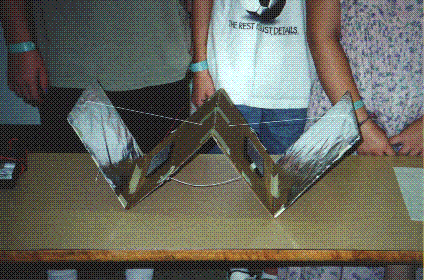![[I&D]](../sml_hdh-cog.gif) HOME |
![[I&D]](../sml_intro.gif) INTRO |
![[I&D]](../sml_index.gif) INDEX |
![[I&D]](../sml_modules.gif) MODULES |
![[I&D]](../sml_other_resources.gif) RESOURCES |
![[I&D]](../sml_search.gif) EDUCATION |
![[I&D]](../sml_button_write.gif) COMMENTS |
![[I&D]](../sml_hdh-cog.gif) HOME |
![[I&D]](../sml_intro.gif) INTRO |
![[I&D]](../sml_index.gif) INDEX |
![[I&D]](../sml_modules.gif) MODULES |
![[I&D]](../sml_other_resources.gif) RESOURCES |
![[I&D]](../sml_search.gif) EDUCATION |
![[I&D]](../sml_button_write.gif) COMMENTS |

In many developing countries, dense forest prevents collection of sunlight for power; but above the canopy there is plenty of sunlight. The Skytent can be used with a balloon to lift it to that level. It also employs reflectors to increase the amount of energy it takes in. This way it collects the most energy possible for the community.
The Skytent consists of five major parts. The unit itself is made of four sheets of lightweight plastic in a "W" formation. The sheests are hinged for adjustability. These hinges also make it collapsible for easy storage. The solar cells are placed on the inner parts of the "W". The reflectors are placed opposite the cells. A helium balloon is used to support the unit and four cords are attached to the balloon and to the ground to prevent the unit form drifting.
The Skytent was mostly tested indoors for light consistency and for reasons regarding current. Outside there was more current than the multimeter can read, so adjustments were make impossible. We conducted all further current tests inside where the light levels were considerably lower. While inside we found that if we positioned the reflectors at approximately 121 degrees we would get the highest current rating.
Voltage was extremely low and had to be tested outside for large enough readings. The highest voltage was approximately .9 volts. This was also attained at an angle of approximately 121 degrees.
At first we brainstormed for ideas. We narrowed it down to 3 ideas. These three ideas were a bubble machine, a balloon, and a tent.
W eventually abandoned the bubble machine. The tent turned into a photovoltaic solar energy collector and combined with the balloon to come up with the device described earlier.
Features
Parts of the Skytent
Test Results
Narrative